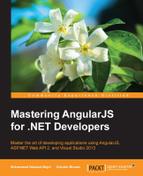Book Description
Master the art of developing applications using AngularJS, ASP.NET Web API 2, and Visual Studio 2013
In Detail
AngularJS is an open source framework that utilizes the Model-View-Controller architecture for client-side application development. AngularJS is referred to as the Angular framework.
With this book, you will soon be able to build client-side data driven applications. The introduction section covers the essentials of AngularJS, covering the core concepts of AngularJS to ensure a smooth transition to the more advanced topics discussed later on.
This book covers the development of client-side applications with AngularJS using code examples before moving on to explore how to build the ASP.NET Web API and its features using Visual Studio .NET.
What You Will Learn
- Understand the architecture of AngularJS
- Discover the uses and working of data binding in AngularJS
- Learn the scope of AngularJS with a thorough understanding of the controller and the filter
- Master the use of $http and $resources to communicate with the server in order to retrieve and post data
- Integrate an AngularJS application with Entity Framework and ASP.NET Web API 2 while learning about the use of JSON objects
- in AngularJS
- Walk through the development environment using the AngularJS NuGet packages
- Learn about troubleshooting and debugging options in an AngularJS application by using different libraries and tools
- Discover the uses of Visual Studio 2013 to build CRUD operations using ASP.NET Web API 2 and AngularJS
- Authenticate and understand security mechanisms for AngularJS applications
Downloading the example code for this book. You can download the example code files for all Packt books you have purchased from your account at http://www.PacktPub.com. If you purchased this book elsewhere, you can visit http://www.PacktPub.com/support and register to have the files e-mailed directly to you.
Table of Contents
- Mastering AngularJS for .NET Developers
- Table of Contents
- Mastering AngularJS for .NET Developers
- Credits
- About the Authors
- About the Reviewers
- www.PacktPub.com
- Preface
- 1. Introduction
- 2. Learning AngularJS Binding and Directives
- 3. AngularJS Scopes, Controllers, and Filters
- 4. Communicating with the Server Using AngularJS
- 5. Creating Applications Using AngularJS, Entity Framework, and ASP.NET Web API
- 6. Using AngularJS and ASP.NET Web API for CRUD Operations
- 7. Troubleshooting and Best Practices
- A. Angular 2.0
- Index
